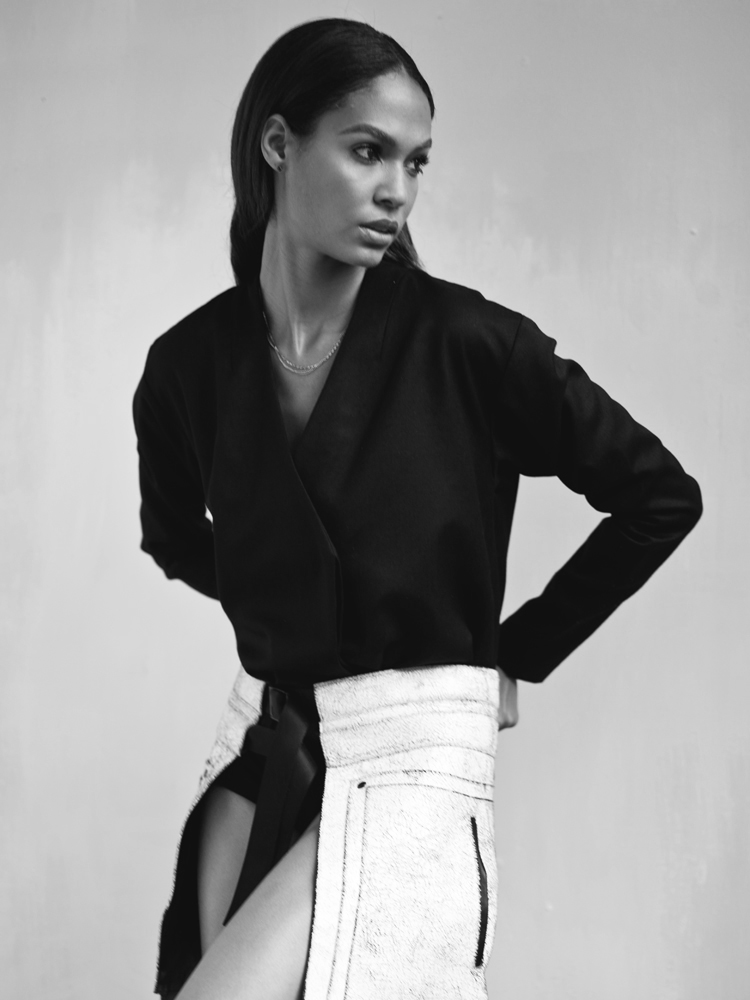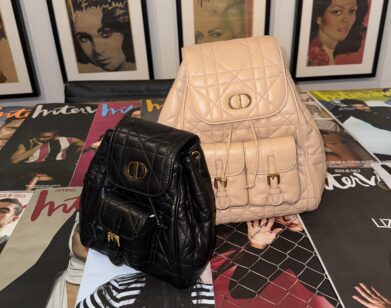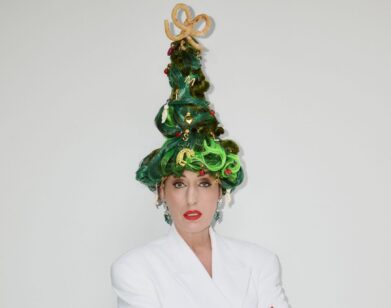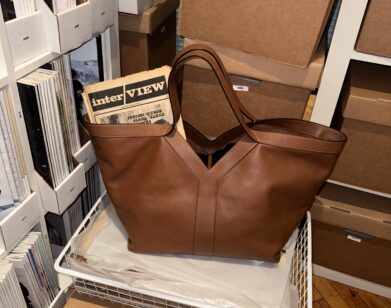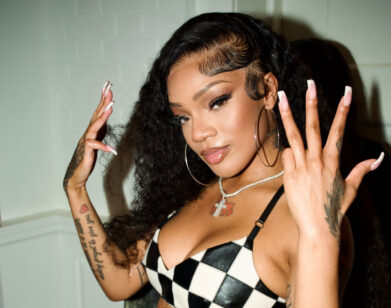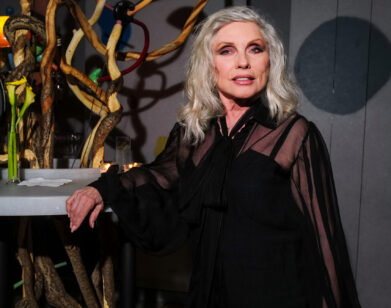Models Off Duty: Joan Smalls x Public School
ABOVE: JOAN SMALLS IN NEW YORK, JUNE 2014. ALL CLOTHING: PUBLIC SCHOOL F/W 2014. PHOTOS: VAN SARKI. STYLING: BRANDON MAXWELL. HAIR: AMOY PITTERS: MAKEUP: SIR JOHN/STREETERS. SPECIAL THANKS: TEDDY TINSON AND BRIDGE ARTISTS.
You’ve heard it before and you’ll hear it again: Public School is a New York label through and through. Designers Dao-Yi Chow and Maxwell Osborne, both New York natives, aren’t fussy about their brand—there is no correct way to wear one of their pieces; you can mix pieces with other designers. Public School is an attitude. “We’re not really the designers that do period inspiration, like Paris in the ’40s or New York meets Saint Tropez,” Chow. “Our approach really starts with that sort of braggadocio feeling of all eyes on you. You’re not standing on top of a mountain waving a flag saying ‘Look at me!’ But you walk into a room and all the eyes go to you,” he continues.
Last February, after winning multiple CFDA Awards for menswear, Public School launched it’s first ever womenswear collection. Their friend Joan Smalls was particularly impressed, and nominated Public School for our Models Off Duty series. Here, Smalls, Osborne, and Chow discuss Public School’s roots, the label’s future, and how they first met.
JOAN SMALLS: How did you first become interested in fashion?
MAXWELL OSBORNE: For me, getting into fashion was kind of a mistake. I was always interested in fashion in terms of what I wore. I was definitely into footwear culture and always made sure I had the best sneakers on and my outfits were really fresh at an early age. That led into me working retail and always being in the arts, going to art school.
SMALLS: Always being creative.
OSBORNE: But I never thought design would be in my realm. Then taking job at a retail store, starting to learn about the product, really seeing products change every season, and sitting on that floor bored as hell, I learned, “Wow, I really am interested in this and the process of making certain clothes.”
SMALLS: So did you go to design school?
OSBORNE: No, I never went to design school. I went to art school. I didn’t really feel like I belonged there either and ended up leaving to take an internship. The design director at the time took me under his wing and pretty much taught me everything to get me started. That led to a designer position and it kept growing from there. So I would say it was all by mistake, because it was definitely not planned. And what a great mistake it was.
SMALLS: What about you, Dao?
CHOW: I got into fashion actually through music—music was my first love.
SMALLS: Any music in particular?
CHOW: Hip-hop. Especially videos and seeing the styling.
SMALLS: What was one video that you can remember where you were like, “Wow, that looks dope.”
CHOW: [laughs] There was so many.
SMALLS: Or an era?
CHOW: Kind of early ’90s or mid-’90s. I was very into collecting old Polo—old Ralph Lauren—that was a big thing in high school. There were so many different rules and ways to put clothes together and going to public school, especially being in the city, you’re always competing against the other kids to look better or to standout from the crowd. I think that’s how it started.
SMALLS: Now that you mention it, who came up with the name Public School?
CHOW: We actually had the name—
OSBORNE: Before we had the brand.
CHOW: We didn’t even know that we wanted it to be called Public School, we just didn’t have a better name. It [became our name] by default.
SMALLS: Did you go to public school, Max?
OSBORNE: Yeah, we both went to public school and we both grew up in New York. Going to public school was a thing that stuck with us and made us into the people we are today—we felt it would be an honor to call it Public School.
SMALLS: And to transform it into something people would not expect. I went to public school as well, so I understand.
OSBORNE: Sitting in a designer space and calling it something like Public School was just a flip on its head. It was really unintimidating and welcoming to everybody else. That’s what public school is—anyone can go to public school.
SMALLS: That’s also inspirational for kids that go to public school to see that you can make it into high fashion, New York Fashion Week, and still bring your history and where you grew up. That’s at least how I would see it, with all your success. I could keep going. [laughs] Do you come from artistic families?
OSBORNE: I definitely don’t come from an artistic family. My mother was very cool, she had me in everything growing up, but, at the end of the day, she’s Jamaican. I’m the first generation of my family born in New York, so my family really wanted all the kids to succeed in doing something that was secure—become a doctor or lawyer. There was nothing outside of that.
CHOW: I don’t come from a creative family either, but I don’t know. I don’t think that’s all the way fair. I come from an Asian family more than anything, so it was very much that you had three careers to choose from: finance, medicine, or law. I have two sisters, and my younger sister is a doctor and my older sister is in finance.
OSBORNE: You were supposed to be the lawyer?
CHOW: [laughs] I definitely was the black sheep. I think my parents expected at a young age that I would be doing something different, but I don’t think that they had any inkling, or me either, that it would be in fashion. But my mom is actually really nice —she can sketch. She used to draw women’s faces on the back of all the telephone bills with a pen and shade it in pen. I always tried to copy her style.
SMALLS: Can you draw?
CHOW: Yeah, I draw a little bit.
SMALLS: Do you still sketch some of the designs?
CHOW AND OSBORNE: Yeah.
SMALLS: Both of you?
OSBORNE: Yeah.
SMALLS: What did you parents think when you told them you wanted to go into design? Did they look at you like you were crazy?
OSBORNE: My mother thought it was a hobby. When I was working for a company and I actually made some money, she was like, “Okay. I get it.”
SMALLS: [laughs]
OSBORNE: But then when we started Public School and we weren’t making any money, she was like, “What the hell are you doing with your life!” Now she’s finally come around and totally embrace it, to the point where I just got a text two days ago: “This would be an awesome t-shirt!” with a slogan that said “P.S. I love Public School.”
CHOW: We can’t use P.S. anymore.
SMALLS: Because of “post script”?
CHOW: Aeropostale has this brand called P.S. We did this J. Crew collab and we had a sweatshirt that said “My P.S. crew” and they sent us a cease and desist letter—to J. Crew and to us—saying that they have a trademark on it. Which is good to know, ’cause now we don’t have to go through the hassle.
SMALLS: How did you reunite after leaving Sean John?
CHOW: We were always friends when we were working there. I left probably six months earlier than Max left. I opened a store down in Miami and Max was helping me with the private label. Doing a store, you go to sales appointments and trade shows and you see how difficult it is for designers who are just starting. You walk by their rack and all their hopes are in the palm of your hand and you’re like, “Mmm. This is cool.” Then you walk by and it’s sort of like, “Fuck.” So I was always like, “Why would anyone want to start their own brand? This shit is crazy!” But through doing our private label for the store and just traveling and doing markets, we felt like there wasn’t anything out there that we really wanted to buy, let alone wear.
SMALLS: So you felt that, as a consumer, you couldn’t get what you wanted so you might as well just design.
CHOW AND OSBORNE: Yeah.
SMALLS: So you kind of did it for yourselves.
OSBORNE: We totally did it to dress ourselves. We spent four or five months, day in, day out, 24 hours a day creating this brand before it officially launched, not knowing really what we were doing but knowing that we were making product that we wanted to wear, which was exciting. It kept us motivated.
SMALLS: Did you feel that when you were working at Sean John you both had the same aesthetics?
OSBORNE: Yeah, we had a similar eye for things and a similar upbringing that gave us a certain edge that made us friends and then co-workers and partners. There was something very organic about it. It wasn’t forced.
CHOW: Even more so than design aesthetic, I think we had the same references relating to areas in New York or people. I’m older than Max by, like, eight years, and eight years is a lot, so for us to have the same reference points was weird. I think that’s originally how we connected. It felt like we grew up together.
OSBORNE: But enough about us! More about you. [reading question] We’re interested in how Smalls got to know Public School.
SMALLS: Did I first meet you through Bernard or Prabal? Or maybe through Kyle. It was at a party or an event, and I didn’t really understand at the time what you did. I was like, “Oh, look at these two stylish guys at a fashion event. Why do people who are in my life know them?” Then I later found out what you did, and Prabal was really excited about you guys. I’m sure you guys paid him a good amount of money to speak so well of you. [laughs]
OSBORNE: He’s expensive.
SMALLS: But he really found you inspiring and very talented. I think that’s something cool, to have a peer support you and talk so well of you.
CHOW: I first met you back in 2008 when we were at Sean John. Bethann [Hardison] was doing a casting for an all-black model show, which we did.
SMALLS: But not the women’s show.
CHOW: Right, only did men.
SMALLS: After I did fittings until two a.m. “They need to see you know for your fitting now!” And then the camera [during the fittings]. I was like, “First of all, I don’t want to be on camera when I’m at my fitting, and second of all, where’s my check?” They never paid me! And when you’re just starting out… That’s all I remember about that. [laughs] What made you decide to get into womenswear?
OSBORNE: For us, getting into women’s was something we always wanted to do and just didn’t have the means to do so. Winning the Vogue Fashion Fund—
SMALLS: The $300,000.
OSBORNE: Right. And with the mentors you get through the Fashion Fund and being able to talk it through, that gave us the confidence to do womenswear.
SMALLS: Was it something you always had in mind?
OSBORNE: Yeah. I think it fast-forwarded it a little bit—on paper we had it slated for a couple of years from now, but it definitely took a fast forward when we won the Fashion Fund.
CHOW: It was also just striking while the iron was hot. Every step that we make has to be a bigger step than the last one, so what would be a bigger step than winning the Fashion Fund? Anna [Wintour] and some of the judges were excited about the prospect, so we fast-tracked it. Also the J. Crew collaboration—when you win the Fashion Fund, you do a collaboration with J. Crew.
SMALLS: For men’s or for women’s?
CHOW: They wanted us to do women’s, so we were like, “Okay, we’ve never done women’s before.”
SMALLS: Do you feel like you keep the same style for girls?
OSBORNE: Yes. Our aesthetic and the point of view for women’s is the same as for men’s.
SMALLS: What would that be? I’m interested to know.
CHOW: It’s street-based. I think people have the misconception of streetwear, but we would like to think it’s how you would dress between shoots—you live in the city and you’re this connector of different circles, you’re doing an interview now and then you’re on a shoot later, then you go meet up with your friends. So bringing all these different circles together, not just downtown, but this idea of the city and the world as one big city.
SMALLS: When you dress women, is it “I would like a girl to dress like that”? I always think about that, if a guy is like, “I want my girl to look like that and this is how I would dress her.” Is that how you feel the collection is? You’re married, right?
CHOW: Yeah.
SMALLS: Would you have your wife dress like that?
CHOW: I think it’s twofold. Ultimately, we believe our woman is going to put it together her own way; to “dress” a woman doesn’t give enough credit to the girl or my wife or whoever we’d want to see in it. The way we style it and put it together for the runway, it’s up for interpretation. We just hope to establish the look and then let you guys figure out how you want to put it ogether. When we design it, we’re not designing it and styling it at the same time. We’re designing what we like and then the girl can put it together. The runway is more the blueprint: you don’t have to rock it exactly that way but the attitude is there. It’s more about the attitude than anything else.
SMALLS: Do you have a preference between designing for men or for women? Are the challenges different?
CHOW: The challenges are definitely completely different. With men’s, it’s such an innate thing—you know how something should fit.
SMALLS: It’s more personal.
CHOW: Yeah, it’s definitely more personal. Then for women there are all these things to consider—
SMALLS: Will it be flattering to the body? Would a woman actually wear it?
CHOW: Exactly. But we’re having a lot of fun doing women. It’s sort of like turning the lights out and feeling it out in the dark. Men’s for us is really second nature: you play with fit, you play with proportion, and you play with fabric, but that’s really it. With women, there are all theses different silhouettes and ideas to explore; draping comes into it a lot more than it does for men.
JOAN SMALLS IS REPRESENTED BY IMG. TO SEE OUR BACKSTAGE PHOTOS FROM PUBLIC SCHOOL’S SPRING/SUMMER 2015 SHOW, CLICK HERE. FOR MORE INFORMATION, VISIT THE LABEL’S WEBSITE.

